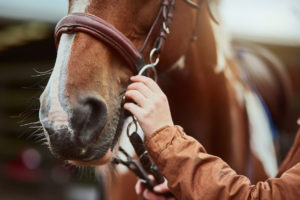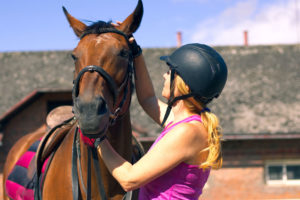It is estimated that more than 30 million Americans ride horses annually – and that more than 2,300 riders under the age of 25 are hospitalized each year due to equestrian injuries.
It might surprise you to learn that horseback riding has a higher injury rate than riding on a motorcycle. After all, horses are large, powerful, and unpredictable animals. They can gallop as fast as 55 mph, and if they fall – or a rider falls off the horse – the impact could be devastating.
Injures from Horseback Riding
The most common injuries sustained from horseback riding occur in the upper extremities – involving the wrist, elbow, and shoulder – which tend to happen when pinned, caught, or flung by a horse. However, the knee, ankle, and foot are also vulnerable during various equestrian activities.
And it’s not just riding – accidents often take place in the stable while handling, feeding, or grooming a horse. There is also the risk of being kicked, bitten, pushed over, or crushed by a horse under certain circumstances, such as when a horse is in conflict with another horse or is fleeing from another horse.
Common injuries while riding or tending horses include:
- Strains and sprains
- Bruises
- Fractures
- Dislocations
- Herniated discs
- Concussions
Traumatic injury to the head is a much less common but nevertheless life-threatening horseback riding injury. Horses have been known to suddenly stop when running, and the momentum throws the rider off of the horse – which can cause severe injury to the rider, particularly if the person lands on their head.
How Can I Avoid Injuries While Riding My Horse?
While it’s understandable that accidents will happen while engaging in certain horseback riding activities, such as jumping and cross-country, other injuries are very avoidable if you take the proper precautions and follow some basic horseback riding safety rules:
Wear a Helmet
Wear an approved, safety-standard hard-shell helmet at all times when mounting and riding a horse. The helmet should always be fastened securely, and you should buy a new one if you ever experience a significant impact. While many trail-riding clubs dispense with this rule, be aware that not wearing a helmet exposes you to a potentially severe injury.
Wear Riding Boots
Be sure you properly match the width of your riding boots to the width of your stirrups in order to avoid getting caught and dragged by a horse. The width of your boot should be only 2 centimeters smaller than the stirrup width – nice and tight, but not too tight.
You may also want to install release catches on your saddle to prevent dragging in case your foot is ever caught. Be sure your feet are correctly positioned in the stirrups.
Wear Proper Clothing
Wear nonskid gloves when riding, and avoid wearing loose-fitting or baggy clothing. You don’t want your clothes to get caught on a branch or other object when riding.
Inspect All Equipment
Maintain and inspect all riding equipment thoroughly before you ride your horse. Consider wearing body-protecting gear to prevent fractures and soft-tissue injuries.
This gear may not protect your spine or chest from a serious blow, but it can spare you from a rib, knee, or elbow injury. Like the helmet, if this gear is ever damaged, get a replacement.
Family Medicine Providers in Wellington
At Advanced Medical Clinic, we treat many horseback riding injuries – as well as other health conditions – in the equestrian community of Wellington, Florida. We pride ourselves on providing personalized, quality health care for you and your entire family.
To learn more about us and about the primary medical care services we offer, or to arrange a visit to our friendly South Florida clinic, call us at (561) 434-1935 or request an appointment using our online form. We are always happy to serve you.



